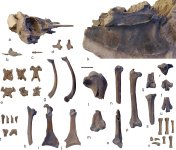Fred Ruhe
Well-known member

Gerald Mayr & Andrew C. Kitchener, 2023
Multiple skeletons of Rhynchaeites from the London Clay reveal
the osteology of early Eocene ibises (Aves, Threskiornithidae)
Vol. 0123456789)1 3PalZ
0123456789)1 3PalZ
Abstract and free pdf: Multiple skeletons of Rhynchaeites from the London Clay reveal the osteology of early Eocene ibises (Aves, Threskiornithidae) - PalZ
We describe a new species of Rhynchaeites from the early Eocene London Clay of Walton-on-the-Naze (Essex, UK), which is represented by a partial skeleton comprising a skull and most major postcranial bones. Multiple further partial skeletons are assigned to Rhynchaeites sp. and include skeletal elements that are rarely preserved in Paleogene birds. Rhynchaeites is for the first time included in a phylogenetic analysis, which did not unambiguously resolve its affinities, but provided weak support for a sister group relationship to the Threskiornithidae. If Rhynchaeites is a stem group representative of ibises, its skeletal morphology indicates significant homoplasy in the evolution of Aequornithes, the higher level clade including the Threskiornithidae and most other aquatic or semi-aquatic birds. In particular, Rhynchaeites has much shorter legs than extant ibises and the new fossils show that its palate was schizognathous. Current phylogenies suggest that a desmognathous palate as well as long legs evolved multiple times independently within Aequornithes. Unlike in extant ibises, the tip of the beak of Rhynchaeites lacks a densely pitted surface. We hypothesize that vision played a greater role in the foraging strategy of Rhynchaeites, whereas extant ibises are tactile probers and use their beaks for “remote sensing”
The paper describes Rhynchaeites litoralis, sp. nov.
Another new species from the Daniels collection.
Enjoy,
Fred
Multiple skeletons of Rhynchaeites from the London Clay reveal
the osteology of early Eocene ibises (Aves, Threskiornithidae)
Vol.
Abstract and free pdf: Multiple skeletons of Rhynchaeites from the London Clay reveal the osteology of early Eocene ibises (Aves, Threskiornithidae) - PalZ
We describe a new species of Rhynchaeites from the early Eocene London Clay of Walton-on-the-Naze (Essex, UK), which is represented by a partial skeleton comprising a skull and most major postcranial bones. Multiple further partial skeletons are assigned to Rhynchaeites sp. and include skeletal elements that are rarely preserved in Paleogene birds. Rhynchaeites is for the first time included in a phylogenetic analysis, which did not unambiguously resolve its affinities, but provided weak support for a sister group relationship to the Threskiornithidae. If Rhynchaeites is a stem group representative of ibises, its skeletal morphology indicates significant homoplasy in the evolution of Aequornithes, the higher level clade including the Threskiornithidae and most other aquatic or semi-aquatic birds. In particular, Rhynchaeites has much shorter legs than extant ibises and the new fossils show that its palate was schizognathous. Current phylogenies suggest that a desmognathous palate as well as long legs evolved multiple times independently within Aequornithes. Unlike in extant ibises, the tip of the beak of Rhynchaeites lacks a densely pitted surface. We hypothesize that vision played a greater role in the foraging strategy of Rhynchaeites, whereas extant ibises are tactile probers and use their beaks for “remote sensing”
The paper describes Rhynchaeites litoralis, sp. nov.
Another new species from the Daniels collection.
Enjoy,
Fred
Last edited:




